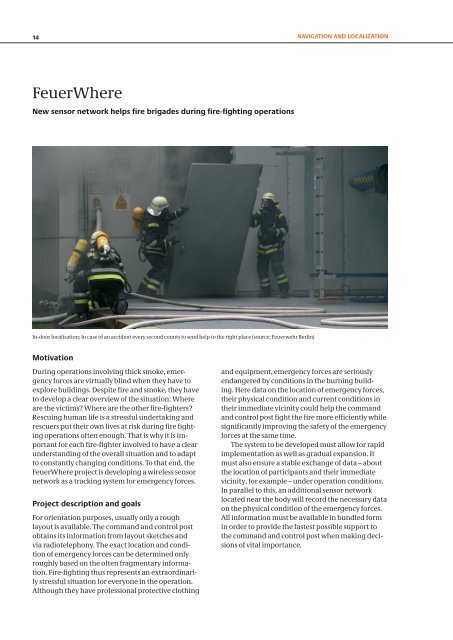Research for Civil Security
Research for Civil Security
Research for Civil Security
- No tags were found...
Create successful ePaper yourself
Turn your PDF publications into a flip-book with our unique Google optimized e-Paper software.
14 NavIgatION aND lOCalIzatIONFeuerWhereNew sensor network helps fire brigades during fire-fighting operationsIn-door localisation: In case of an accident every second counts to send help to the right place (source: Feuerwehr Berlin)motivationDuring operations involving thick smoke, emergency<strong>for</strong>ces are virtually blind when they have toexplore buildings. Despite fire and smoke, they haveto develop a clear overview of the situation: Whereare the victims? Where are the other fire-fighters?Rescuing human life is a stressful undertaking andrescuers put their own lives at risk during fire fightingoperations often enough. That is why it is important<strong>for</strong> each fire-fighter involved to have a clearunderstanding of the overall situation and to adaptto constantly changing conditions. To that end, theFeuerWhere project is developing a wireless sensornetwork as a tracking system <strong>for</strong> emergency <strong>for</strong>ces.Project description and goalsFor orientation purposes, usually only a roughlayout is available. The command and control postobtains its in<strong>for</strong>mation from layout sketches andvia radiotelephony. The exact location and conditionof emergency <strong>for</strong>ces can be determined onlyroughly based on the often fragmentary in<strong>for</strong>mation.Fire-fighting thus represents an extraordinarilystressful situation <strong>for</strong> everyone in the operation.Although they have professional protective clothingand equipment, emergency <strong>for</strong>ces are seriouslyendangered by conditions in the burning building.Here data on the location of emergency <strong>for</strong>ces,their physical condition and current conditions intheir immediate vicinity could help the commandand control post fight the fire more efficiently whilesignificantly improving the safety of the emergency<strong>for</strong>ces at the same time.The system to be developed must allow <strong>for</strong> rapidimplementation as well as gradual expansion. Itmust also ensure a stable exchange of data – aboutthe location of participants and their immediatevicinity, <strong>for</strong> example – under operation conditions.In parallel to this, an additional sensor networklocated near the body will record the necessary dataon the physical condition of the emergency <strong>for</strong>ces.All in<strong>for</strong>mation must be available in bundled <strong>for</strong>min order to provide the fastest possible support tothe command and control post when making decisionsof vital importance.
















